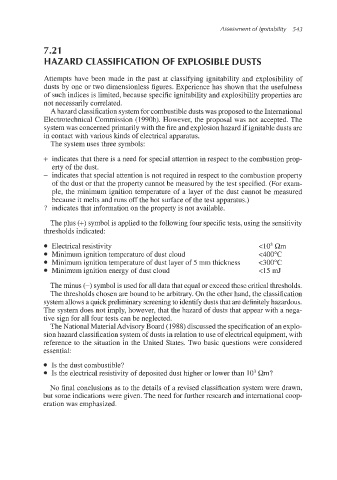Page 576 - Dust Explosions in the Process Industries
P. 576
Assessment of lgnitability 543
7.2 1
HAZARD CLASSIFICATION OF EXPLOSIBLE DUSTS
Attempts have been made in the past at classifying ignitability and explosibility of
dusts by one or two dimensionless figures. Experience has shown that the usefulness
of such indices is limited, because specific ignitability and explosibility properties are
not necessarily correlated.
A hazard c1assi:ficationsystemfor combustibledusts was proposed to the International
Electrotechnical Commission (1990b). However, the proposal was not accepted. The
system was concernedprimarily with the fire and explosion hazard if ignitable dusts are
in contact with various kinds of electrical apparatus.
The system uses three symbols:
+ indicates that there is a need for special attention in respect to the combustion prop-
erty of the dust.
- indicates that special attention is not required in respect to the combustion property
of the dust or that the property cannot be measured by the test specified. (For exam-
ple, the minimum ignition temperature of a layer of the dust cannot be measured
because it melts and runs off the hot surface of the test apparatus.)
? indicates that information on the property is not available.
The plus (+) symbol is applied to the following four specific tests, using the sensitivity
thresholds indicafzed:
0 Electrical resistivity <lo3Qm
0 Minimum ignition temperature of dust cloud <4OO0C
0 Minimum ignition temperature of dust layer of 5 mm thickness <300"C
0 Minimum ignition energy of dust cloud <15 mJ
The minus (-) symbol is used for all data that equal or exceed these critical thresholds.
The thresholds chosen are bound to be arbitrary. On the other hand, the classification
system allows a quick preliminary screeningto identify dusts that are definitelyhazardous.
The system does not imply, however, that the hazard of dusts that appear with a nega-
tive sign for all four tests can be neglected.
The National MaterialAdvisory Board (1988) discussedthe specification of an explo-
sion hazard classification system of dusts in relation to use of electrical equipment, with
reference to the situation in the United States. Two basic questions were considered
essential:
0 Is thie dust combustible?
0 Is the electrical resistivity of deposited dust higher or lower than lo3Qm?
No final conclusions as to the details of a revised classification system were drawn,
but some indicatilons were given. The need for further research and international coop-
eration was emphasized.

